Print date for the Gentleman’s Magazine…
July 23, 2012 by TimHughes · Leave a Comment
 Actual printing dates of monthly magazines have always been difficult to establish, but some times dated news reports will give some indication. An advertisement for the Gentleman’s Magazine in the “Daily Post-Boy” of London, September 4, 1732, provides a valuable clue for the earliest issues of this title (it began publishing in 1731). Note that the advertisement has at the top: “September 2 was published…The Gentleman’s Magazine…for August, 1732…”. So at least during the early years of this magazine’s existence it printed a few days after the end of the month.
Actual printing dates of monthly magazines have always been difficult to establish, but some times dated news reports will give some indication. An advertisement for the Gentleman’s Magazine in the “Daily Post-Boy” of London, September 4, 1732, provides a valuable clue for the earliest issues of this title (it began publishing in 1731). Note that the advertisement has at the top: “September 2 was published…The Gentleman’s Magazine…for August, 1732…”. So at least during the early years of this magazine’s existence it printed a few days after the end of the month.
Another interesting tidbit is provided in this advertisement as well. We knew that the first several issues of the first year of “Gentleman’s Magazine” printed at least six editions, as some were noted as such on the title/contents page, but we never knew when they were reprinted. Note the very bottom of this advertisements mentions: “…Where may be had, The former Numbers, except Numb 1 and Numb. II which will be republished a 4th Time in a few days.” This indicates that the fifth edition of the January and February, 1731 issues were printed in the first week of September, 1732.
The Traveler… going through withdrawal… setting an example…
May 7, 2012 by The Traveler · Leave a Comment
Today I found myself in London with the London Gazette dated May 8, 1712. I found that they had a reward for the apprehension of a gentleman by the name of Charles Guill. Mr. Guill “has belonged to the Bank of England, from whose Service he withdrew himself on the 3d Instant, with several Exchequer-Bills and the following Bank Notes…”. The article also provides a very interesting detail of his appearance and attire as well as the reward for his apprehension.
Another brief article is of the punishment a Robert Kingston received from pretending to be two other persons. He was sentenced to stand in the Pillory (stockades) on Tower-hill, which is where the executions were held. He was “to deter others from the like Practices”. He may have been setting an example for others, but I bet he was thinking that he was grateful that he had not received the punishment of those on Tower-hill!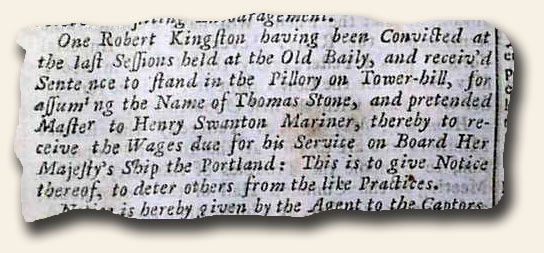
~The Traveler
Happy Passover… Happy Easter…
April 6, 2012 by GuyHeilenman · Leave a Comment
President George Washington is known for his letters to various Hebrew congregations (Newport, Savannah, etc.) and churches which are filled with spiritual references. Considering the recipients, such language might be expected even if the writer was not a person of faith. However, the following is a speech he gave to the leaders of Philadelphia upon his visit to the city while in transit to New York to take the oath of office. At a time when he could have said anything, what he chose to say and how he chose to say it speaks volumes. Please enjoy his address as it appeared in The Massachusetts Centinel, May 2, 1789: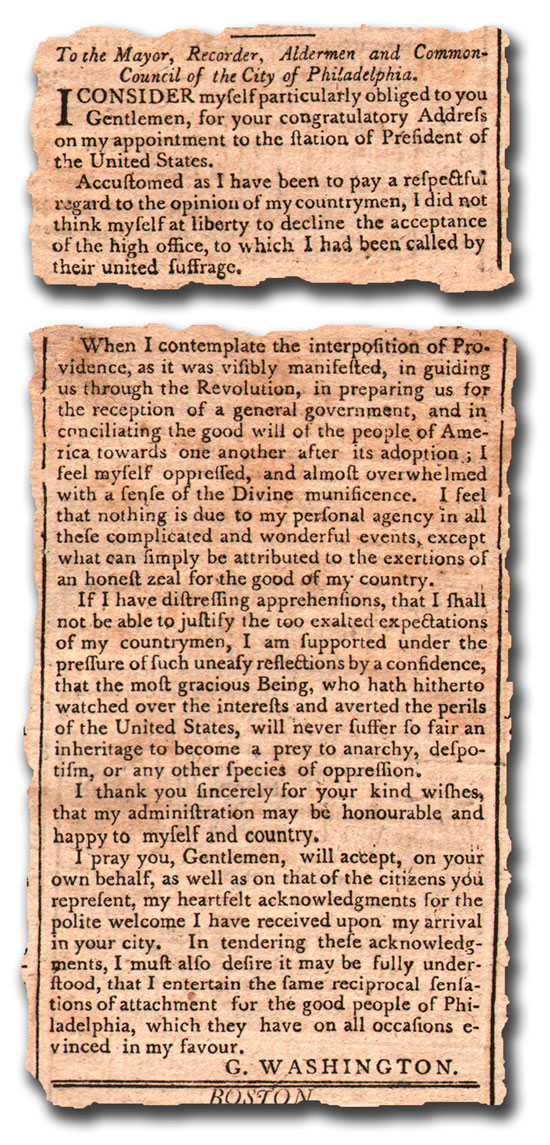
The Traveler… the Czar gets married… loose lips…
April 2, 2012 by The Traveler · 1 Comment
Today’s travels took me to The London Gazette of April 5, 1712 where I found the Czar of Mosco (Moscow) has publicly solemnized his wedding with his Empress  Catherina Alexewna. The wedding had to be deferred for some time by reason his Czarish Majesty’s “making the Campaign the last Summer.” The article provides details of the wedding.
Catherina Alexewna. The wedding had to be deferred for some time by reason his Czarish Majesty’s “making the Campaign the last Summer.” The article provides details of the wedding.
Another article on the front page is of the Suedes (Swedes) making advancement into Pomerania before the Danes could hinder them. Two officers of the Swedish Fleet had been condemned “to have their Heads struck off, for having held a Correspondence with the Danes, and their Father, who was privy to these Actions of his Sons, and did not discover them, is confin’d to a perpetual Imprisonment…” There are times it is just better to keep the lips sealed. Whereas some have been known to sink ships, this is even worse…
~The Traveler
Be careful what you print…
January 7, 2012 by TimHughes · Leave a Comment
“The Norwich Gazette” newspaper from England, May 24, 1729, includes the sentences for several people involved in publishing a certainly issue of “Mist’s Journal” which apparently had content unfavorable to the authorities. Once defendant was sentenced: “…to walk round the four courts in Westminster Hall with a paper on his forehead denoting his offence, and to suffer one month’s imprisonment…”. See the other sentences as well: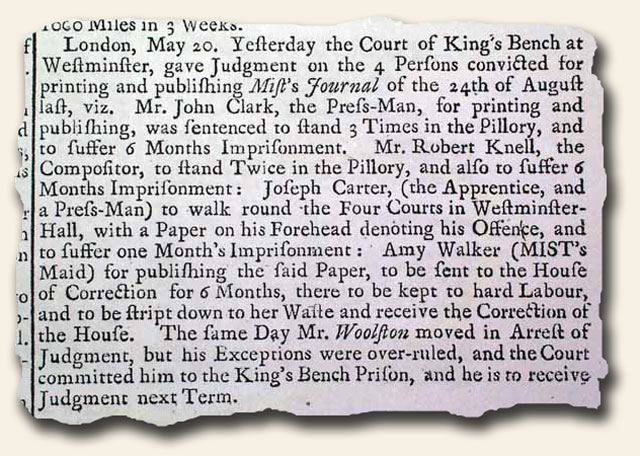
Pennsylvania’s first newspapers…
December 12, 2011 by TimHughes · Leave a Comment
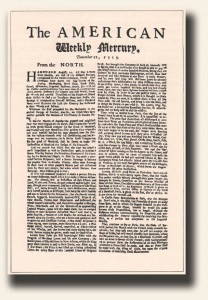 It was only in Boston where a newspaper came off a printing press prior to any in Pennsylvania. It was 15 years after the “Boston News-Letter” of 1704 (not counting the one-issue run of Boston’s “Publick Occurrences Both Foreign & Domestick” in 1690) when, on December 22, 1719, Andrew Bradford began his “American Weekly Mercury” (see image) in Philadelphia, Pennsylvania’s first newspaper. This weekly would last until 1746.
It was only in Boston where a newspaper came off a printing press prior to any in Pennsylvania. It was 15 years after the “Boston News-Letter” of 1704 (not counting the one-issue run of Boston’s “Publick Occurrences Both Foreign & Domestick” in 1690) when, on December 22, 1719, Andrew Bradford began his “American Weekly Mercury” (see image) in Philadelphia, Pennsylvania’s first newspaper. This weekly would last until 1746.
But certainly the most successful newspaper in the colony, if not in all of colonial America, was the “Pennsylvania Gazette” begun in December, 1728 by Samuel Keimer. Within a year it was purchased by Benjamin Franklin. As Oswald notes: “…Under Franklin’s guidance, there appeared for the first time a colonial newspaper produced by a man of education who was in addition a capable printer, a versatile writer, and energetic news gatherer and an enterprising & resourceful businessman. This combination had the inevitable result of placing the “Pennsylvania Gazette” in the lead, and it thereby established a model for others to follow.” The “Gazette” would make Franklin a wealthy man and his name appeared on the imprint through 1765.
Pennsylvania has the distinction of having America’s first daily newspaper, the “Pennsylvania Evening Post & Daily Advertiser“, which started publication in 1775 as a tri-weekly and became a daily on May 30, 1783.
For sale: an army, and more…
December 10, 2011 by TimHughes · Leave a Comment
This tongue-in-cheek “For Sale By Auction…A Warlike Nation” advertisement appeared in “The Connecticut Courant” newspaper of Hartford, August 19, 1783, shortly after the end of the Revolutionary War. It offers some biting commentary on thoughts of the politicians of England and the military leadership after losing the Revolutionary War. Enjoy…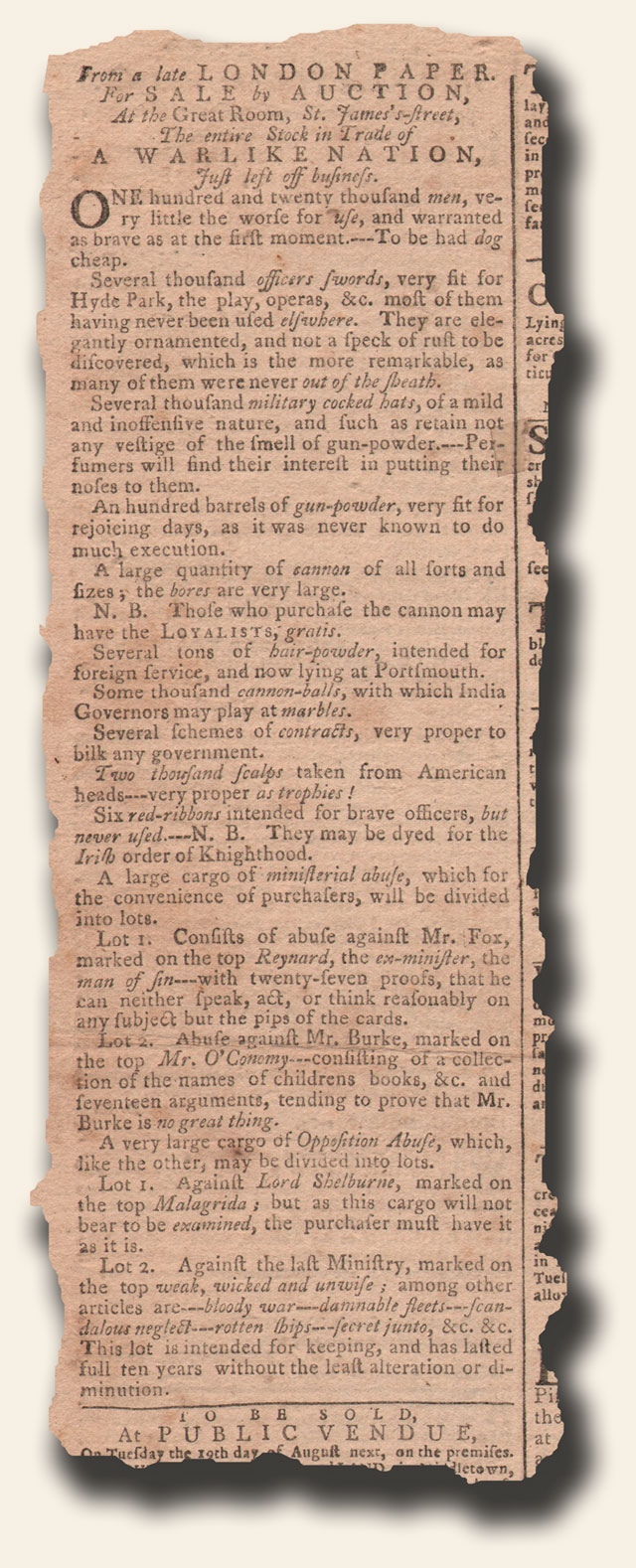
When did the “Gentleman’s Magazine” print the Declaration of Independence?
November 14, 2011 by TimHughes · 5 Comments
 Fellow collector Michael Gulvin asks a question which many other collectors may have wondered: “On what day of the month did the Gentleman’s Magazine for August, 1776 become available? We have a time-line for the American newspapers, and we know that the London Chronicle printed the Declaration in its August 17th issue, but do we know the actual date the Gentleman’s Magazine printed the Declaration of Independence for its August issue?”
Fellow collector Michael Gulvin asks a question which many other collectors may have wondered: “On what day of the month did the Gentleman’s Magazine for August, 1776 become available? We have a time-line for the American newspapers, and we know that the London Chronicle printed the Declaration in its August 17th issue, but do we know the actual date the Gentleman’s Magazine printed the Declaration of Independence for its August issue?”
Magazines typically published very late in the month shown on the title/contents page. With the “London Chronicle” publishing the Declaration of Independence in its August 17, 1776 issue, and presuming they had interest in publishing such a significant document as early as possible, it is presumed the Declaration was received in London very close to that date. Their previous issue was dated Aug. 15, so August 15-17 would be the presumed period when the document arrived in London. It is curious to note that the “London Gazette” never printed the Declaration of Independence.
Monthly publications are more difficult to pin down in terms of publication dates, however datelines of news reports found within offer great clues. The Historical Chronicle near the back of the August issue of the “Gentleman’s Magazine” has datelines beginning July 10 and the latest date mentioned is August 31, the very last day of the month. Obviously the magazine could not have printed prior to August 31, so the first day or two of September would be the presumed printing dates.
The same was true with American magazines as I recall the June, 1776 issue of “The Pennsylvania Magazine” had the very significant announcement that Congress had voted to approve the Declaration of Independence, with a dateline of July 2, 1776. Obviously that June issue was printed early the following month.
Colonial newspaper founded by a woman… A rare find…
October 31, 2011 by TimHughes · Leave a Comment
A recent collection which came into our inventory included a rare title which didn’t strike me until I looked more closely.
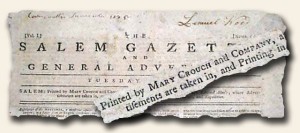 “Salem Gazette” is a somewhat common from the 18th century so I wasn’t surprised to see the title when quickly examining the collection. But then I noticed the date from the Revolutionary War, which I thought odd. Upon investigation I found there were actually four different newspapers titled “Salem Gazette“, one from 1774-1775, one from 1781-85, and one from 1790 thru the 19th century. These latter two are were quite familiar to me, but our issue was yet a fourth title, one which I had never encountered in 35 years, and this one lasted but 36 issues during the year 1781. But of greater significance was that the masthead noted it was published by a woman, Mary Crouch. See the hyperlink for much more on her fascinating life, but suffice it to say she was no stranger to publishing a newspaper as she had much experience in South Carolina.
“Salem Gazette” is a somewhat common from the 18th century so I wasn’t surprised to see the title when quickly examining the collection. But then I noticed the date from the Revolutionary War, which I thought odd. Upon investigation I found there were actually four different newspapers titled “Salem Gazette“, one from 1774-1775, one from 1781-85, and one from 1790 thru the 19th century. These latter two are were quite familiar to me, but our issue was yet a fourth title, one which I had never encountered in 35 years, and this one lasted but 36 issues during the year 1781. But of greater significance was that the masthead noted it was published by a woman, Mary Crouch. See the hyperlink for much more on her fascinating life, but suffice it to say she was no stranger to publishing a newspaper as she had much experience in South Carolina.
The hyperlinked article mentions she took over the publication of her husband’s (Charles) “South Carolina Gazette” after he died in 1772. She then began her own newspaper, the “Charlestown Gazette“, in August of 1778. When the British occupied her town in 1780, being a staunch patriot, she moved north to Salem, Massachusetts, where she began publishing this “Salem Gazette” in 1781. The number we have is dated February 6, 1781 and is issue number 6 of the 36 published (see the hyperlink). Relatively few institutions hold any issues of this title, and only four issues of this date are held by institutions.
There were a number of women who published newspapers in the 18th century & virtually all that I could discover did so by continuing a printing business upon the demise of their respective husbands. One exception was Mary Goddard who published the “Maryland Journal” during her brother’s absence from 1774-1783. But Anne Catherine Green took over her late husband’s “Maryland Gazette” upon his death in 1767; Hannah Watson took over her husband’s (Ebenezer) “Connecticut Courant” upon his death in 1777; Margaret Draper took over the “Massachusetts Gazette” upon the death of her husband Richard in 1774; Clementine Rind took over “The Virginia Gazette” in 1773 when her husband William died; and Ann Franklin published the “Newport Mercury” upon the death of her son James in 1762. I am sure there are others as well.
From what I could determine Mary Crouch may well be the first American woman to create a newspaper, and she did so twice. Her first being the “Charlestown Gazette” and her second the “Salem Gazette“. Any research to the contrary would be gratefully received and shared with our fellow collectors.
Where is Polypotamia today?
September 12, 2011 by TimHughes · Leave a Comment
 The “Maryland Gazette” of April 30, 1784 includes a small yet fascinating report from Congress that ten new states cut out of the Western Territory had bee created, but none of the states are as we know them today.
The “Maryland Gazette” of April 30, 1784 includes a small yet fascinating report from Congress that ten new states cut out of the Western Territory had bee created, but none of the states are as we know them today.
Through the information provided by QalaBist.com we learn that the state of Sylvania was proposed to include much of present-day Minnesota, Michigan’s Upper Peninsula and some of northern Wisconsin. The State of Michigania was proposed to include most of Wisconsin, but nothing of Michigan. The State of Chersonesus (the Greek word for peninsula) was proposed to include most of Michigan’s Lower Peninsula. The State of Assenispia (named after the Assenisipi River, also known as the Rock River.) was proposed to include the northern part of modern-day Indiana. The State of Metropotamia was proposed to include southern Michigan and parts of northern Ohio and Illinois. The State of Illinoia was proposed to include most of Illinois. The State of Saratoga was proposed to include most of Indiana. The State of Washington was proposed to include most of Ohio. The State of Polypotamia was proposed to include most of western Kentucky. The State of Pelisipia was proposed to include most of eastern Kentucky.
A fascinating piece of American history not known by most.


